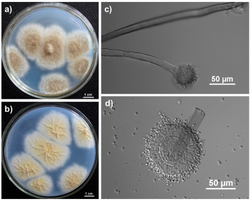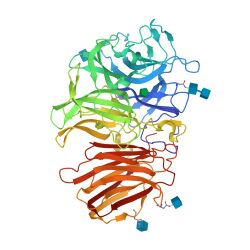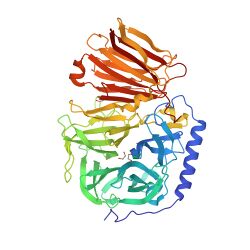Biology:Inulinase
Inulinase (EC 3.2.1.7 and EC 3.2.1.8, inulase, endoinulinase, endo-inulinase, exoinulinase, 2,1-β-D-fructan fructanohydrolase) is an enzyme with systematic name 1-β-D-fructan fructanohydrolase.[1][2] It catalyses the reaction
- Endohydrolysis of (2→1)-β-D-fructosidic linkages in inulin
Inulinase has 2 EC numbers of 3.2.1.7,[3] and 3.2.1.8,[2] for endo- and -exo inulinases, respectively. This classifies it as a hydrolase, specifically a glycosylase of glycosidic nature capable of hydrolyzing O- and S- glycosyl. Due to its chemical reactions, the food industry uses this enzyme to create high fructose syrup. It can be extracted from many tuber vegetables, such as Jerusalem artichoke, dahlia, and chicory.[4]
Reaction mechanism
The enzymatic reaction occurs between the inulinase and the inulin, with the assistance of water via hydrolysis. It's typically done within one step.[5] The reaction centers around the breakage of a bond.[6] The products result in fructose syrup and fructo-oligosaccharide. When these products undergo fermentation, additional products may be formed: lactic acid, bioethanol, citric acid, etc. The mechanisms involved may be considered highly efficient when compared to other enzymes.
Inulinase Production
There are several places for inulinase to be found and produced. A common way is via plants, usually tubular root vegetables (Jerusalem artichoke, dahlia, chicory), where inulinase can be extracted.[7] In this instance, fructose syrup is produced and used by the food industry.[4]

Another way is extraction via bacteria (fungal endophyte, Kluyveromyces marxianus, Cryptococcus aureus). Marine bacteria, yeasts, and fungi are used commonly as well.[8]

Function
As a catalytic enzyme, either endo- or -exo inulinase destroys the bonds of one fructose attached to the inulin chain.[2] Various affinities depending on the environment will affect how the inulinase interacts with the inulin. It functions efficiently between 40-80 degrees Celsius, although depending on the source of the enzyme, it can go as low as 30 degrees Celsius and still work well.[10]
In regards to being tied into a larger metabolism, it helps break down inulin. When people consume inulin (a soluble fiber), the inulinase breaks down the inulin and it goes through fermentation.[11]
Structure

Inulinase contains a N-terminal domain of glycosyl hydrolase family 32 which forms a five bladed beta propeller structure[13] and C terminal domain of glycosyl hydrolase family 32. It forms a beta sandwich module.[13]
The crystal structures are shown here on either side of the page. The two structures of endo-inulinase and exo-inulinase are mainly made of beta-sheets, with the exception of the endo-inulinase, which has one alpha helix. Being made of beta sheets allows the structures to be more stable during chemical reactions.[14]

Active and regulatory sites
Both of the inulinases have different active sites, with exo-inulinase having a funnel shape whereas endo-inulinase has a pocket shape.[16] They're complicated due to the amino acids needing to be a balance of catalytic and conserved to achieve a stable enzymatic active site. According to the most recent reference, three amino acids (serine, aspartic acid, and glutamic acid) bind via a hydrogen bond to the fructose molecule that attaches to the exo-inulinase. Whereas with three other amino acids (glutamic acid, tryptophan, and asparagine) those bind via a hydrogen bond to the ketose molecule that attaches to the endo-inulinase.[16]
The structure of the enzymes may or may not influence their function. Each version of the enzyme has about 518 amino acids within its sequence.[12][15] Due to the differences expressed in endo- and exo- inulinases, it will need to be proven or disproven the structure of these enzymes is the reason for the functionality of inulinase.
References
- ↑ "Some enzymes present in highly purified invertase preparations; a contribution to the study of fructofuranosidases, galactosidases, glucosidases and mannosidases". J. Am. Chem. Soc. 65 (7): 1369–1380. 1943. doi:10.1021/ja01247a029.
- ↑ 2.0 2.1 2.2 "Synergistic effect between the recombinant exo-inulinase and endo-inulinase on inulin hydrolysis". Journal of Molecular Catalysis B: Enzymatic 128: 27–38. 2016. doi:10.1016/j.molcatb.2016.03.005. ISSN 1381-1177.
- ↑ "Information on EC 3.2.1.7 - inulinase". https://www.brenda-enzymes.org/enzyme.php?ecno=3.2.1.7#reactschemes.
- ↑ 4.0 4.1 "Production of inulinase from Kluyveromyces marxianus using dahlia tuber extract". Brazilian Journal of Microbiology 43 (1): 62–69. January 2012. doi:10.1590/S1517-83822012000100007. PMID 24031804.
- ↑ "Applications of Fungal Inulinases" (in en). Encyclopedia of Mycology. Elsevier. 2021. pp. 337–347. doi:10.1016/b978-0-12-819990-9.00016-0. ISBN 978-0-323-85180-0.
- ↑ "Production, characterization and application of inulinase from fungal endophyte CCMB 328". Anais da Academia Brasileira de Ciências 84 (2): 443–454. June 2012. doi:10.1590/S0001-37652012005000035. PMID 22634747.
- ↑ 7.0 7.1 "Utilization of inulin-containing waste in industrial fermentations to produce biofuels and bio-based chemicals". World Journal of Microbiology & Biotechnology 33 (4): 78. April 2017. doi:10.1007/s11274-017-2241-6. PMID 28341907.
- ↑ "Inulinase-expressing microorganisms and applications of inulinases". Applied Microbiology and Biotechnology 82 (2): 211–220. February 2009. doi:10.1007/s00253-008-1827-1. PMID 19122997.
- ↑ "Helianthus tuberosus L. GRIN-Global". https://npgsweb.ars-grin.gov/gringlobal/taxon/taxonomydetail?id=27946.
- ↑ Purification and characterization of extracellular inulinase from a marine yeast Cryptococcus aureus G7a and inulin hydrolysis by the purified inulinase. Applied Biochemistry and Biotechnology. 144. February 2008. pp. 111–121. doi:10.1007/s12010-007-8025-y.
- ↑ "Understanding the Physics of Functional Fibers in the Gastrointestinal Tract: An Evidence-Based Approach to Resolving Enduring Misconceptions about Insoluble and Soluble Fiber" (in English). Journal of the Academy of Nutrition and Dietetics 117 (2): 251–264. February 2017. doi:10.1016/j.jand.2016.09.021. PMID 27863994.
- ↑ 12.0 12.1 "Crystal structure of exo-inulinase from Aspergillus awamori: the enzyme fold and structural determinants of substrate recognition". Journal of Molecular Biology 344 (2): 471–480. November 2004. doi:10.1016/j.jmb.2004.09.024. PMID 15522299.
- ↑ 13.0 13.1 "The three-dimensional structure of invertase (beta-fructosidase) from Thermotoga maritima reveals a bimodular arrangement and an evolutionary relationship between retaining and inverting glycosidases". The Journal of Biological Chemistry 279 (18): 18903–10. April 2004. doi:10.1074/jbc.M313911200. PMID 14973124.
- ↑ "Molecular Mechanics of Beta-Sheets". ACS Biomaterials Science & Engineering 6 (4): 1940–1949. April 2020. doi:10.1021/acsbiomaterials.9b01983. PMID 33455356.
- ↑ 15.0 15.1 (in en) Structure of GH32 hydrolase from Bifidobacterium adolescentis in complex with frutose. 2020-02-05. doi:10.2210/pdb6nun/pdb. http://dx.doi.org/10.2210/pdb6nun/pdb. Retrieved 2022-10-24.
- ↑ 16.0 16.1 "Molecular modeling and docking of microbial inulinases towards perceptive enzyme-substrate interactions". Indian Journal of Microbiology 52 (3): 373–380. September 2012. doi:10.1007/s12088-012-0248-0. PMID 23997327.
External links
- Inulinase at the US National Library of Medicine Medical Subject Headings (MeSH)
 |

